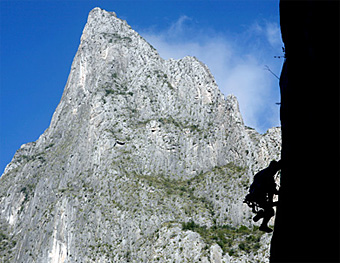
|
 |
 |
 Travel & Outdoors | January 2008 Travel & Outdoors | January 2008  
Adventure Guide to Mexico
Rock Climbing: El Potrero Chico
 Bonnie Tsui - NYTimes Bonnie Tsui - NYTimes
go to original


| | Since the climbing scene in Mexico has yet to take off, most of the climbs have been developed by Americans in the last decade. | | |
About an hour northwest of Monterrey, a craggy limestone outcrop named El Potrero Chico has been quietly attracting rock climbers from around the world. What makes the area unusual is the sheer variety of the 600-plus bolted routes — in which permanent artificial anchors are embedded in the rock — all within easy access of a campground and lodge at the base of the rock.

The icing on the cake? You won’t have to share. The crowd typically tops out at 50 or 60 people, mostly a mix of Americans and Canadians and some Europeans; on many days, you’ll probably encounter just a handful of other climbers.

Since the climbing scene in Mexico has yet to take off, most of the climbs have been developed by Americans in the last decade, and routes are usually christened with quirky Spanish or English names (Estrellita, Treasure of Sierra Madre, Yankee Clipper).

The bolting of routes directly into the rock makes the rugged terrain more accessible to a wider spectrum of climbers; an average Joe can easily try a beginner climb next to an awesome Jane working on a longer, more complicated route. Limestone uplift makes for a combination of crags, spires and ridges. The terrain and loose rock conditions are the kind of thing you’d find in the backcountry (think the Wind River range in Wyoming), but here, it’s all fixed-bolt sport climbing instead of traditional climbing, in which climbers place their own gear to protect against falls.

Long, moderate sport routes make El Potrero Chico a friendly place for climbers to work on their skills. Posada El Potrero Chico is a family-run campsite and lodge owned by a local resident named Luís Lozano. It serves the sporting crowd with Wi-Fi, new casitas and a small gear shop.

El Potrero Chico is just west of the small town of Hidalgo, where the living is simple, with street markets and hearty food typical of northern Mexico — nopalitos, carne asada, gorditas. To encourage climbing and environmental efforts in the community, the climbing school runs cleanup days in which local children help with the maintenance of routes by collecting trash.

“It’s a quiet and safe town with all of the services,” said Mr. Lozano, who grew up in Hidalgo. “People return year after year, and some of the climbers have already moved here.”

Posada El Potrero Chico, (52-1) 81-8362-6672; www.elpotrerochico.com.mx; weeklong guided climbing trips from $1,511 a person, including guide, equipment, airport shuttle and lodging in a casita with private bath; November through March.


Bonnie Tsui is editor of “A Leaky Tent Is a Piece of Paradise” (Sierra Club), a collection of essays on the outdoors. | 
 | |
 |



